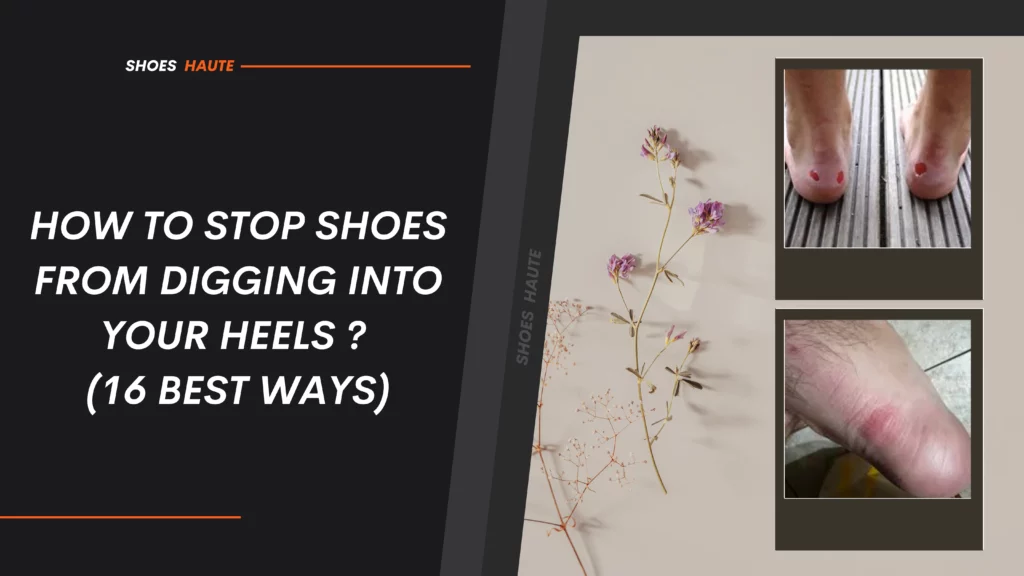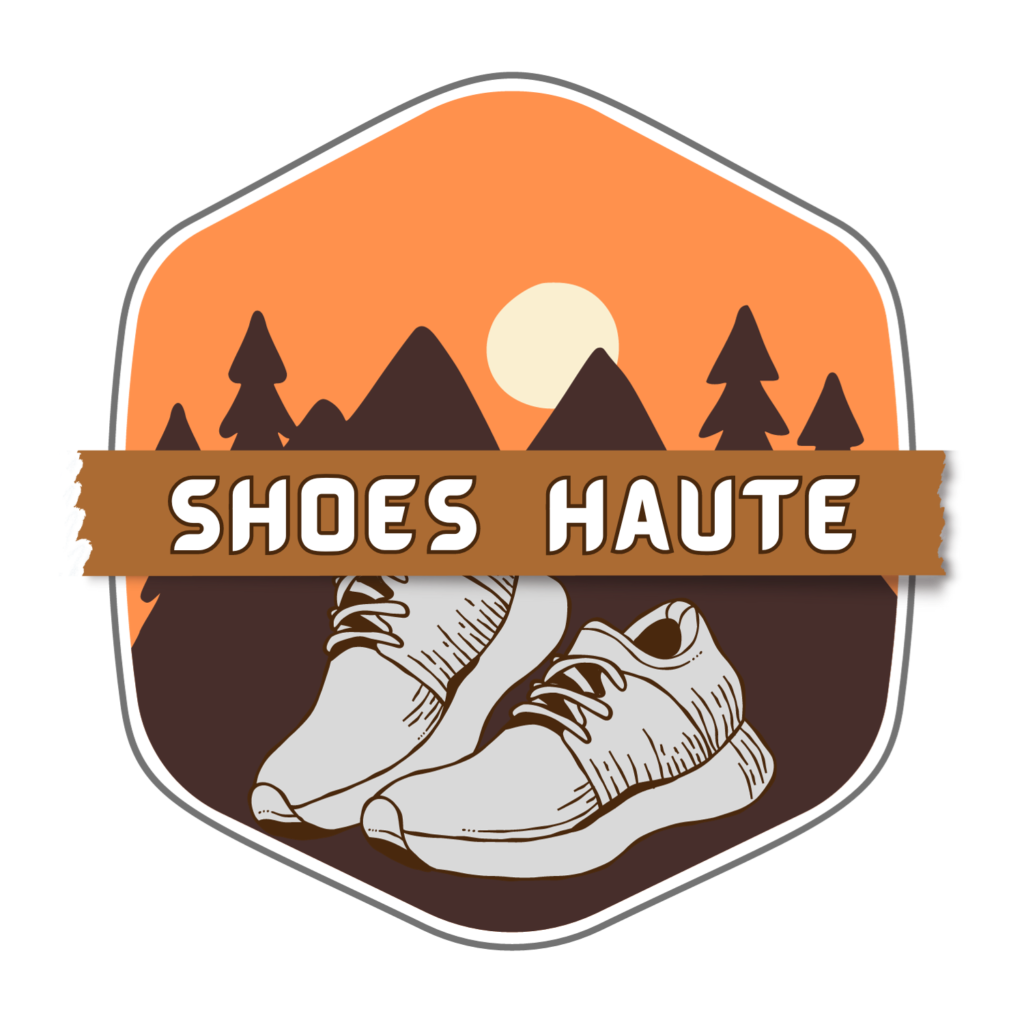
Have you ever experienced the uncomfortable sensation of your shoes digging into the back of your heels, resulting in painful wiggling? This common problem can be attributed to various factors such as poorly fitting footwear or excessive physical activity. However, regardless of the cause, the outcome is usually the same: discomfort, blisters, and potentially even injuries. Therefore, it is crucial to address this issue promptly to ensure both immediate relief and the long-term well-being of your feet.
This article will explore various techniques and approaches to avoid shoes causing discomfort and digging into the heels. It caters to athletes, professionals with hectic schedules, or anyone seeking more comfortable footwear. The topics discussed range from selecting the right shoes to incorporating cushioning and padding for pain-free and comfortable feet.
If you’re tired of wearing uncomfortable shoes, continue reading to discover more information!
Gaining Insight into the Problem (How To Stop Shoes From Digging Into Heels)
I understand the frustration that comes with experiencing discomfort caused by shoes that dig into your heels. To address this issue effectively, it is crucial to gain insight into the underlying reasons behind it.
Now, let’s examine some of the most common causes of shoes digging into the heels, the anatomy of the foot and heel, and methods to determine if your shoes are the cause of the problem.
- In order to comprehend the reasons behind shoes digging into the heels, it is helpful to have a grasp of the foot and heel structure. The heel, located at the back of the foot, comprises both bone and soft tissue. The application of pressure or friction to this region can result in discomfort, pain, and potential injury.
- One of the primary causes of shoes digging into heels is an ill-fitting pair. Footwear that is either too large or too small can create friction and rubbing against the back of the heel, resulting in blisters and irritation.
- Even if your shoes fit properly, they can still cause problems if they have areas of tightness or pressure around the heel. This can occur due to design flaws in the shoe or because the feet swell during physical activity.
- The materials utilized in the construction of your shoes can also play a role in causing discomfort in the heels. Shoes made from stiff materials or featuring rough edges can irritate the skin and lead to the formation of blisters.
How To Prevent Shoes From Digging Into Your Heels
Fed up with the painful experience of shoes digging into your heels? Don’t fret! I have some effective techniques to help you steer clear of this problem.
By implementing these strategies, you can effectively prevent your shoes from causing painful discomfort in your heels, allowing you to enjoy your footwear and maintain comfort throughout the day.
16 Best Ways To Stop Shoes From Digging Into Your Heels
Here are 16 effective ways/methods you can utilize to prevent shoes from digging into your heels.
Method 1: Choose The Correct Size
- Ensuring the proper shoe size is crucial to prevent heel pain caused by ill-fitting footwear. Wearing shoes that are either too small or too big can lead to issues such as blisters, calluses, and even plantar fasciitis.
- To accurately determine the appropriate size, it is recommended to measure your feet at the end of the day when they are most swollen. Additionally, it is advisable to measure both feet as there may be a slight difference in size between them.
- For a guaranteed perfect fit, make sure to try on shoes while wearing the socks you plan to pair them with. Additionally, take a walk in the shoes to assess their comfort and fit. There should be approximately a thumb’s width of space between your longest toe and the front of the shoe, and the shoe should neither feel too tight nor slip off while walking.
- It is important to keep in mind that sizes can differ depending on the brand and style of shoes, hence it is advisable to try them on before making a purchase. In the case of online shopping, it is recommended to consult the brand’s sizing chart and read user reviews to determine if the shoes tend to run big or small. Putting in the effort to obtain the correct size can greatly help in avoiding heel pain and discomfort.
Method 2: Wearing The Proper Socks

- Choosing the appropriate socks is crucial to prevent your shoes from causing discomfort in your heels. Consider the material, fit, and thickness when selecting socks. Opt for moisture-wicking options like wool or synthetic fibers, as they help keep your feet dry and minimize friction.
- Avoid cotton socks as they tend to absorb moisture and can result in blisters. Ensure that the socks fit properly, neither too tight nor too loose. Tight socks can restrict blood flow and cause discomfort, whereas loose socks may bunch up and cause friction. Additionally, consider the thickness of the socks when making a choice.
- Thinner socks offer better breathability and help maintain coolness in your feet, while thicker socks provide enhanced cushioning and absorb shock effectively.
- To prevent the build-up of bacteria and unpleasant odors, it is recommended to wear fresh socks daily. Additionally, selecting the appropriate socks can help prevent shoes from causing discomfort and rubbing against the heels while running.
Method 3: Use Of Plasters

- Plasters can serve as a preventive measure against blisters or as a protective layer for existing blisters. They act as a barrier between the skin and the shoe, reducing friction and irritation. When applying plasters, it is important to choose the right size and shape to adequately cover the affected area. Specifically designed for blisters, these plasters are often thicker and feature a cushioned pad that helps absorb pressure and alleviate discomfort.
- Before applying a plaster, it is crucial to ensure that the affected area is clean and dry. This can be achieved by washing the area with soap and water, followed by gently drying it with a clean towel.
- Using a plaster directly on an open blister can cause further irritation, which is why it is recommended to use a blister plaster with a cushioned pad. This type of plaster provides protection against pressure and friction. In the case of a burst blister, it is advisable to apply a sterile dressing to prevent infection and promote healing.
- To keep the area clean and dry, it is important to change plasters regularly. If the plaster becomes wet or starts to peel, it should be replaced with a new one. It is recommended to avoid removing the plaster too early as it could cause more irritation and delay the healing process. If there are any concerns about the blister or if it does not seem to be healing, it is advisable to seek help from a healthcare professional.
Method 4: Use Of Insoles

- Using insoles is an effective method to prevent shoes from causing discomfort on your heels. They provide additional cushioning and support, making it easier to wear your shoes for extended periods. Insoles are typically constructed from different materials, including gel, foam, and cork, and come in various thicknesses and designs to suit different shoe types.
- Selecting the appropriate size and shape of insoles for your shoe and foot is crucial. Additionally, you can opt for insoles that offer additional features such as arch support or shock absorption for enhanced comfort and protection. To use insoles, simply remove the existing insole from your shoe and replace it with the new one.
- Custom orthotics, also known as personalized insoles, offer valuable benefits for individuals with specific foot ailments or concerns, as they are meticulously crafted by podiatrists to cater to the unique needs of your feet, addressing any discomfort or difficulties you may be experiencing.
- Consulting with a podiatrist to explore the potential benefits of custom insoles is advisable if you are experiencing specific foot ailments or discomfort, as personalized orthotics may provide relief for your symptoms.
Method 5: Use Of Heel Grips Or Pads

- To prevent shoes from causing discomfort and blisters by digging into your heels, an effective solution is to utilize heel grips or padding. These accessories are designed to enhance the fit of shoes by reducing sliding and rubbing, resulting in increased comfort. Typically made of a soft and cushioning material, heel grips adhere to the inside of your shoes, providing an additional layer of protection for your heels.
- Selecting the appropriate size and type of heel grips or pads is crucial when using them. In addition to adhesive pads, there are silicone heel cups and foam pads that can be inserted into the back of your shoes as alternative options. It may be necessary to experiment with different varieties to find the most suitable one for your specific needs.
- Heel grips or pads are particularly useful when dealing with slightly oversized shoes, as they effectively fill in any excess space and prevent your feet from sliding inside the shoe. They are also a wise option for shoes that are particularly rigid or uncomfortable, as the added cushioning offers relief and support.
- In conclusion, heel grips or cushions are a convenient and effective solution to prevent shoes from causing discomfort or irritation to your heels. They are affordable and widely available, making them easily accessible, and they can greatly enhance the overall comfort and fit of your shoes.
Method 6: Use Of Moleskin

- Moleskin, a gentle adhesive material, is frequently employed to shield the skin from blisters, sores, and other irritations. Using moleskin can be a highly effective method to prevent shoes from causing discomfort or friction on your heels.
- Prior to applying moleskin, it is recommended to clean and dry the affected area of your foot. Next, carefully cut a piece of moleskin that is slightly larger than the area where rubbing occurs.
- Once the moleskin has been cut to the desired size, peel off the backing and apply it directly onto your skin. Ensure that the moleskin fully covers the affected area by aligning it properly. If the moleskin feels too thick or uncomfortable, you may need to trim it down to a thinner size.
- Moleskin is readily accessible in drugstores and supermarkets, providing a cost-effective and effective means to prevent shoes from causing discomfort on your heels. However, it is important to remember that moleskin is not a permanent fix and should be replaced regularly to maintain its effectiveness.
- Additionally, it is important to avoid using moleskin on broken or infected skin. Moreover, individuals with diabetes or other foot disorders should exercise caution and consult with a healthcare professional before considering the use of moleskin.
Method 7: Use Of Tongue Pads
- A useful solution to prevent shoes from causing discomfort and pressure on your heels is by using a tongue pad. The tongue pad is a small cushioning pad that is inserted behind the tongue of your shoe, providing relief for the top of your foot and redistributing your weight forward.
- Tongue pads are typically made of foam or gel and are available in different thicknesses, providing various levels of cushioning. These pads are easy to apply as they are self-adhesive, allowing you to stick them effortlessly to the inside of your shoe.
- Before applying a tongue pad, it is important to clean the inside of your shoe to ensure proper adhesion. Peel off the backing from the adhesive of the tongue pad and carefully insert it beneath the tongue of your shoe. Position it in a way that it covers the specific area of your foot that is feeling pressure or discomfort.
- For added comfort and support, tongue pads can be used in combination with other options like heel grips or insoles. This affordable and uncomplicated solution is particularly beneficial for individuals experiencing pain on the top of their foot or the front of their shoe.
- When correctly positioned and maintained, tongue pads can effectively alleviate discomfort and protect your heels from being irritated by your shoes.
Method 8: Use Of Vaseline
- Based on personal experience, I have discovered that using Vaseline is an excellent solution for preventing shoes from causing discomfort by digging into your heels.
- This cheap and straightforward remedy works by reducing friction between your skin and the shoe, making it an effective solution.
- To utilize Vaseline, just apply a small amount to the back of your heels or any other areas that frequently rub against your shoes. Ensure an even application and use a minimal amount that covers the affected area. This method effectively reduces friction and helps prevent the development of blisters.
- One advantage of using Vaseline is its easy availability and suitability for daily use. It can also be reapplied as necessary throughout the day, particularly if you anticipate extensive walking or standing.
- When applying Vaseline, it is important to be mindful of a few things. Since it can be messy, allow it to absorb into your skin before putting on your shoes. Additionally, it is essential to note that Vaseline is not a long-lasting solution and may require multiple applications throughout the day.
- overall, Vaseline is a cost-effective and effective method to prevent shoes from causing discomfort by digging into your heels. It is a great option for individuals on a tight budget or those who prefer not to invest in pricier alternatives.
Method 9: Reduce Moisture
- I have found that one of the simplest ways to avoid shoes digging into your heels is by reducing moisture. Wet feet can lead to friction and painful blisters. To prevent moisture, it is helpful to wear breathable shoes and socks, utilize foot powder, and make sure to change your socks regularly. These measures effectively minimize the risk of discomfort caused by dampness.
- Breathable shoes can reduce the problem by letting your feet breathe and allowing air to circulate. This helps in keeping your feet dry and preventing sweat from building up inside your shoes. Wearing socks made of natural fibers like cotton or wool can also help decrease dampness by absorbing sweat and allowing it to evaporate.
- To prevent moisture buildup, foot powder can be applied to your feet before wearing socks or inside your shoes. It helps absorb moisture and keeps your feet dry. Make sure to select a foot powder specifically designed for this purpose and avoid talc-based ones, as they can be harmful if inhaled.
- Lastly, regularly changing your socks can help reduce moisture and prevent blisters.
Method 10: Use Kinesiology Tape
- Kinesiology tape is a flexible and adhesive tape commonly used for treating muscle and joint injuries and reducing pain. It can also be helpful in preventing shoe rubbing and discomfort on the heels. To start using kinesiology tape, make sure the area around your heels is clean and dry. Then, cut a piece of tape that is long enough to wrap around your heel and extend up the back of your shoe.
- To keep the tape from coming off, make sure to round the edges. Place one end of the tape on the inside of your shoe, just above the heel. Then, wrap the tape around your heel, ensuring it sticks closely to your skin. Keep stretching and smoothing the tape up the back of your shoe.
- Kinesiology tape is designed to be flexible, providing support and cushioning for your heels while allowing natural movement. It also helps prevent friction and rubbing, which can lead to painful blisters.
- One great thing about using kinesiology tape is that it’s easy to adjust and remove whenever necessary. If the tape starts to come off or becomes uncomfortable, you can simply peel it off and replace it. Additionally, you can use it in different ways, like as heel grips or insoles, to add extra comfort and support.
- In my opinion, kinesiology tape is a simple and effective solution for preventing shoes from causing discomfort and blisters on your heels. It serves as a gentle and flexible barrier between your skin and the shoes, reducing friction and irritation.
Method 11: Use Anti-Blister Heel Balm
- In my view, anti-blister heel balm is a remedy that effectively prevents the development of blisters on your heels by minimizing friction between your skin and shoes. The balm is formulated with various beneficial ingredients such as shea butter, beeswax, and jojoba oil, which work together to soothe and nourish your skin.
- To use the anti-blister heel balm, just apply a small amount to your heels before putting on your shoes. This will create a protective layer between your skin and the shoe, minimizing friction and effectively preventing blisters.
- Applying an anti-blister heel balm offers the benefit of being non-invasive and non-slip. Unlike bandages or tape, the balm won’t come off during the day or make the inside of your shoe slippery. Additionally, it won’t leave any sticky residue on your skin or cause any damage to your shoes.
- Another advantage of using anti-blister heel balm is that it can be applied as a preventive measure, even if you don’t currently have any blisters. By applying the balm before putting on your shoes, you can effectively reduce the likelihood of developing blisters in the first place.
- In addition to preventing blisters, anti-blister heel balm also helps to soothe and hydrate dry, cracked, or calloused skin on your heels. Regularly applying the balm can help keep your skin soft and supple, ultimately reducing the likelihood of developing blisters.
- Using an anti-blister heel balm is an easy and efficient method to ensure your feet stay comfortable throughout the day.
Method 12: Use Duct Tape
- One alternative method to prevent shoes from digging into your heels is by using duct tape, a powerful adhesive tape that can be utilized for various tasks, such as alleviating shoe blisters.
- Before applying the duct tape, ensure that your feet are clean and dry.
- Take a piece of duct tape that is sufficiently long to cover the affected area of your heel and cut it accordingly.
- Carefully apply the duct tape to the area of your heel where the shoe is causing discomfort. Make sure to smooth out any wrinkles or air pockets to ensure that the tape adheres smoothly to your skin.
- If the tape starts to come off or loses its stickiness depending on what you’re doing, simply remove it and replace it with a fresh piece.
- Duct tape is a cost-effective solution for preventing shoe blisters, making it particularly advantageous when you’re in a hurry and need a quick fix.
- However, it’s important to be aware that duct tape can cause irritation to sensitive skin and potentially trigger an allergic reaction. If you experience any discomfort or irritation, it’s best to remove the tape and explore alternative methods.
Method 13: Use A Blow Dryer

- A practical technique to prevent your shoes from digging into your heels is using a blow dryer to stretch the back of them. This method involves heating up the shoe material, which makes it more flexible and easier to mold to the shape of your foot.
- To stretch your shoes, start by wearing a pair of thick socks. Next, put on the shoes you want to stretch and aim the blow dryer at the back of the shoes where they dig into your heels. Make sure to keep the blow dryer approximately 6 inches away from the shoes and move it around to evenly heat the targeted area.
- While the shoes are being warmed up, wiggle your toes and flex your feet to aid in shaping them to your feet. It’s important to leave the shoes on until they have cooled down to maintain their newly formed shape. After they have cooled, try them on without socks to assess their comfort. If they still feel too tight, you can repeat the blow-drying process until they reach the desired level of stretch.
- When using a blow dryer to stretch your shoes, it’s crucial to be patient. Rushing the process can cause damage to the material and ultimately ruin your shoes. Start by heating and cooling them in short intervals, and gradually increase the time as necessary. This method is highly effective for leather shoes and can also be used for other materials.
- Using a blow dryer to stretch your shoes is a great way to make them more comfortable and prevent them from causing pain or blisters, particularly in the heel area. This method is not only simple and easy but also cost-effective. It helps break in the shoes and ensures a better fit, enhancing overall comfort.
Method 14: Use Cotton Wool
- You can easily use cotton wool, a common household item, to protect your heels from shoes that dig into them. This technique works particularly well when dealing with shoes that are too wide, causing your heels to slip and resulting in painful blisters. By using cotton wool, you can create a protective barrier and prevent discomfort.
- To utilize cotton wool, take a small amount and shape it into a ball. Then, carefully place the cotton wool ball at the back of your shoe, right where your heel rests. Ensure that it fits securely against your heel to prevent any movement while walking.
- Cotton wool acts as a barrier between your heel and the back of your shoe, diminishing friction and preventing the formation of blisters. Additionally, the soft and smooth texture of the cotton wool provides extra cushioning, resulting in added comfort when wearing your shoes.
- It’s important to understand that while cotton wool can provide temporary relief from blisters, it’s not a permanent solution. If you find that your shoes consistently rub against your heels, it may be a sign that they are not the right size or style for you. In such cases, it’s advisable to explore different sizes or models of shoes to ensure a better fit and avoid ongoing discomfort.
Method 15: Stretch The Back Of Your Shoes
- Experiencing shoes that dig into your heels can be quite painful and uncomfortable. One effective approach to alleviate this discomfort is to stretch the back of your shoes. This method helps to alleviate pressure and reduce friction, ultimately providing relief from the pain.
- There are various techniques available to stretch the back of your shoes.
- A simple way to do this is by using ice. All you have to do is put a small plastic bag filled with water into your shoe and push it towards the back.
- To prevent your shoes from stretching too much, be sure to use a water bag that isn’t too big. Put your shoes in the freezer for a couple of hours, then take them out and let the ice melt before removing the bag. This will cause the material to expand, effectively stretching the back of the shoes. If necessary, you can repeat this process.
- Another option for stretching the back of your shoes is to use A Shoe Stretching Tool. You can find these tools at shoe stores or online. They are designed to stretch the shoe material in a gentle manner, providing a more comfortable fit.
- Lastly, you can use cotton balls or a thick pair of socks to stretch your shoes. Simply place the cotton balls or socks at the back of your shoes and leave them there for a few hours or overnight. This method helps stretch the fabric, making your shoes more comfortable to wear.
Method 16: Use Anti-Friction Sticks
- An effective way to prevent your shoes from causing discomfort or blisters on your heels is by using anti-friction sticks. These sticks are designed to reduce friction between your skin and the inside of your shoes, thus minimizing the chances of painful foot issues like blisters. Typically, they are made of a wax-like substance that can be applied to either the skin or the inside of the shoe.
- To use an anti-friction stick, all you need to do is apply a thin layer to the affected area of your foot or the inside of your shoe. This creates a protective barrier that reduces friction and helps prevent the development of blisters. The great thing about these sticks is that they have a long-lasting effect, so you don’t have to reapply them frequently.
- Using an anti-friction stick has the advantage of being incredibly user-friendly and conveniently portable. Additionally, individuals with sensitive skin or allergies to certain ingredients can benefit from its use as it is commonly made from natural components, providing them with a suitable alternative.
- You have the flexibility to choose from a range of sizes and types when it comes to anti-friction sticks, ensuring that you find one that suits your specific needs. There are sticks designed specifically for feet, as well as others that can be used on any area of your body that experiences friction. You can conveniently purchase these sticks either online or at nearby drugstores or sporting goods stores.
Some Useful Tips
- To prevent wearing the same pair of shoes too often, it is recommended to regularly switch between different pairs.
- As a experienced person, it is advisable to wear socks with your shoes in order to minimize friction and prevent the occurrence of blisters.
- it is important to regularly moisturize your feet to prevent them from becoming dry and cracked.
- If you anticipate being on your feet for a prolonged duration, it is recommended to take occasional breaks.
don’t know how to clean adidas cloudform shoes ? https://shoeshaute.com/how-to-clean-adidas-cloudfoam-shoes-a-unique-cleaning-method/
Conclusion
I hope now you have got your answer about “ How To Stop Shoes From Digging Into Your Heels”.
In conclusion, implementing proactive measures to prevent shoes from digging into your heels can significantly improve your foot health and overall comfort. I encourage readers to explore the various techniques and remedies mentioned in this article, allowing them to discover the most suitable solution for their individual needs.
By taking these precautions, you can enjoy walking without concerns or discomfort caused by shoe pain.
FAQ’s
What leads to the issue of shoes digging into your heels?
The problem of shoes digging into heels can arise from various factors such as inadequate fit, tightness or pressure points, as well as the materials used in the shoes. Additionally, wearing the wrong shoe size can also contribute to this discomfort.
Is it possible for me to continue wearing my favorite shoes despite the discomfort they cause by digging into my heels?
Absolutely, there are solutions available to help you continue wearing your beloved shoes even if they dig into your heels. Consider using heel grips or pads, moleskin, or tongue pads to alleviate the discomfort. Another option is to try stretching the shoes or applying duct tape to prevent them from digging into your heels.
At what point should I seek medical attention for foot or heel pain?
If you experience persistent or severe foot or heel discomfort, it is advisable to consult a doctor or podiatrist. Additionally, symptoms such as swelling, redness, numbness, or difficulty walking may indicate a more serious foot or heel condition that should prompt medical attention.
For individuals with flat feet or high arches, is it possible to prevent shoes from digging into their heels?
By opting for shoes that provide sufficient arch support and cushioning, individuals with flat feet or high arches can minimize the likelihood of shoes pressing into their heels. Additionally, incorporating shoe inserts like orthotics or arch support insoles can help distribute pressure evenly across the feet, reducing friction on the heels.
Is it possible to wear high-heeled shoes while attempting to prevent them from digging into the heels?
While aiming to avoid shoes digging into your heels, it is still possible to wear heels by selecting the appropriate type and ensuring a proper fit. Opt for heels with a wider heel base and adequate arch support. Additionally, using heel inserts or pads can be beneficial in reducing friction and relieving pressure on the heels.





